Protein Binding's Role in Clinical Drug Development and Resistance
VerifiedAdded on 2023/04/25
|7
|1296
|445
Report
AI Summary
This report delves into the crucial role of protein binding in clinical drug development, particularly in the context of antimicrobial drugs. It highlights how protein binding affects drug efficacy, distribution, metabolism, and elimination. The report discusses various protein targets in bacteria and the resistance mechanisms that bacteria employ against antimicrobials. It also emphasizes the significance of plasma protein binding, including its impact on drug absorption and the potential interactions between multiple drugs consumed simultaneously. Furthermore, the report provides an overview of common plasma proteins influencing drug efficacy, such as human serum, lipoprotein, glycoprotein, and globulins. This comprehensive analysis underscores the importance of understanding protein binding to optimize drug development and combat antimicrobial resistance. Desklib provides access to a wealth of resources, including past papers and solved assignments, to aid students in their studies.

Running head: IMPORTANCE OF PROTEIN BINDING
Name of the student
Name of the university
Author note:
Name of the student
Name of the university
Author note:
Paraphrase This Document
Need a fresh take? Get an instant paraphrase of this document with our AI Paraphraser
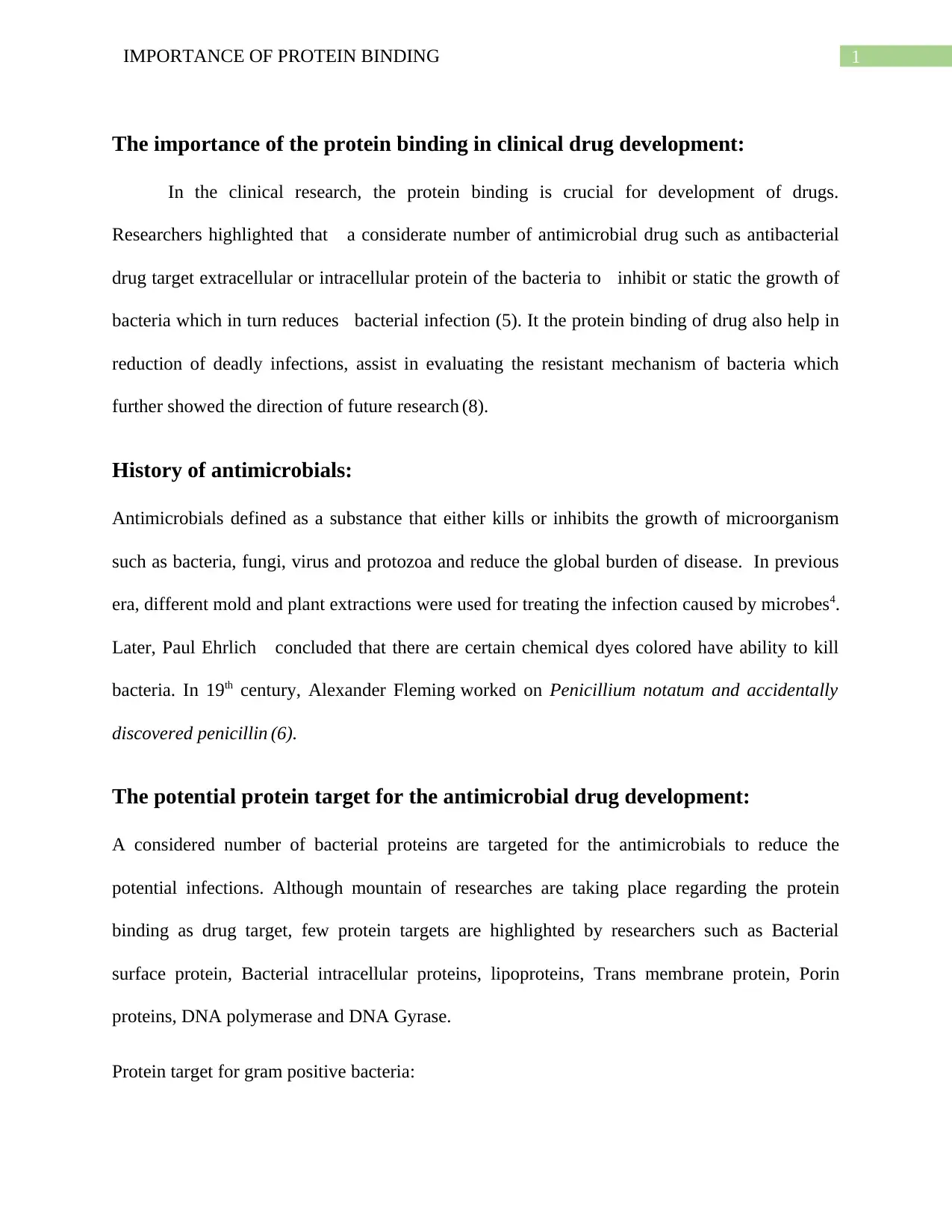
1IMPORTANCE OF PROTEIN BINDING
The importance of the protein binding in clinical drug development:
In the clinical research, the protein binding is crucial for development of drugs.
Researchers highlighted that a considerate number of antimicrobial drug such as antibacterial
drug target extracellular or intracellular protein of the bacteria to inhibit or static the growth of
bacteria which in turn reduces bacterial infection (5). It the protein binding of drug also help in
reduction of deadly infections, assist in evaluating the resistant mechanism of bacteria which
further showed the direction of future research (8).
History of antimicrobials:
Antimicrobials defined as a substance that either kills or inhibits the growth of microorganism
such as bacteria, fungi, virus and protozoa and reduce the global burden of disease. In previous
era, different mold and plant extractions were used for treating the infection caused by microbes4.
Later, Paul Ehrlich concluded that there are certain chemical dyes colored have ability to kill
bacteria. In 19th century, Alexander Fleming worked on Penicillium notatum and accidentally
discovered penicillin (6).
The potential protein target for the antimicrobial drug development:
A considered number of bacterial proteins are targeted for the antimicrobials to reduce the
potential infections. Although mountain of researches are taking place regarding the protein
binding as drug target, few protein targets are highlighted by researchers such as Bacterial
surface protein, Bacterial intracellular proteins, lipoproteins, Trans membrane protein, Porin
proteins, DNA polymerase and DNA Gyrase.
Protein target for gram positive bacteria:
The importance of the protein binding in clinical drug development:
In the clinical research, the protein binding is crucial for development of drugs.
Researchers highlighted that a considerate number of antimicrobial drug such as antibacterial
drug target extracellular or intracellular protein of the bacteria to inhibit or static the growth of
bacteria which in turn reduces bacterial infection (5). It the protein binding of drug also help in
reduction of deadly infections, assist in evaluating the resistant mechanism of bacteria which
further showed the direction of future research (8).
History of antimicrobials:
Antimicrobials defined as a substance that either kills or inhibits the growth of microorganism
such as bacteria, fungi, virus and protozoa and reduce the global burden of disease. In previous
era, different mold and plant extractions were used for treating the infection caused by microbes4.
Later, Paul Ehrlich concluded that there are certain chemical dyes colored have ability to kill
bacteria. In 19th century, Alexander Fleming worked on Penicillium notatum and accidentally
discovered penicillin (6).
The potential protein target for the antimicrobial drug development:
A considered number of bacterial proteins are targeted for the antimicrobials to reduce the
potential infections. Although mountain of researches are taking place regarding the protein
binding as drug target, few protein targets are highlighted by researchers such as Bacterial
surface protein, Bacterial intracellular proteins, lipoproteins, Trans membrane protein, Porin
proteins, DNA polymerase and DNA Gyrase.
Protein target for gram positive bacteria:
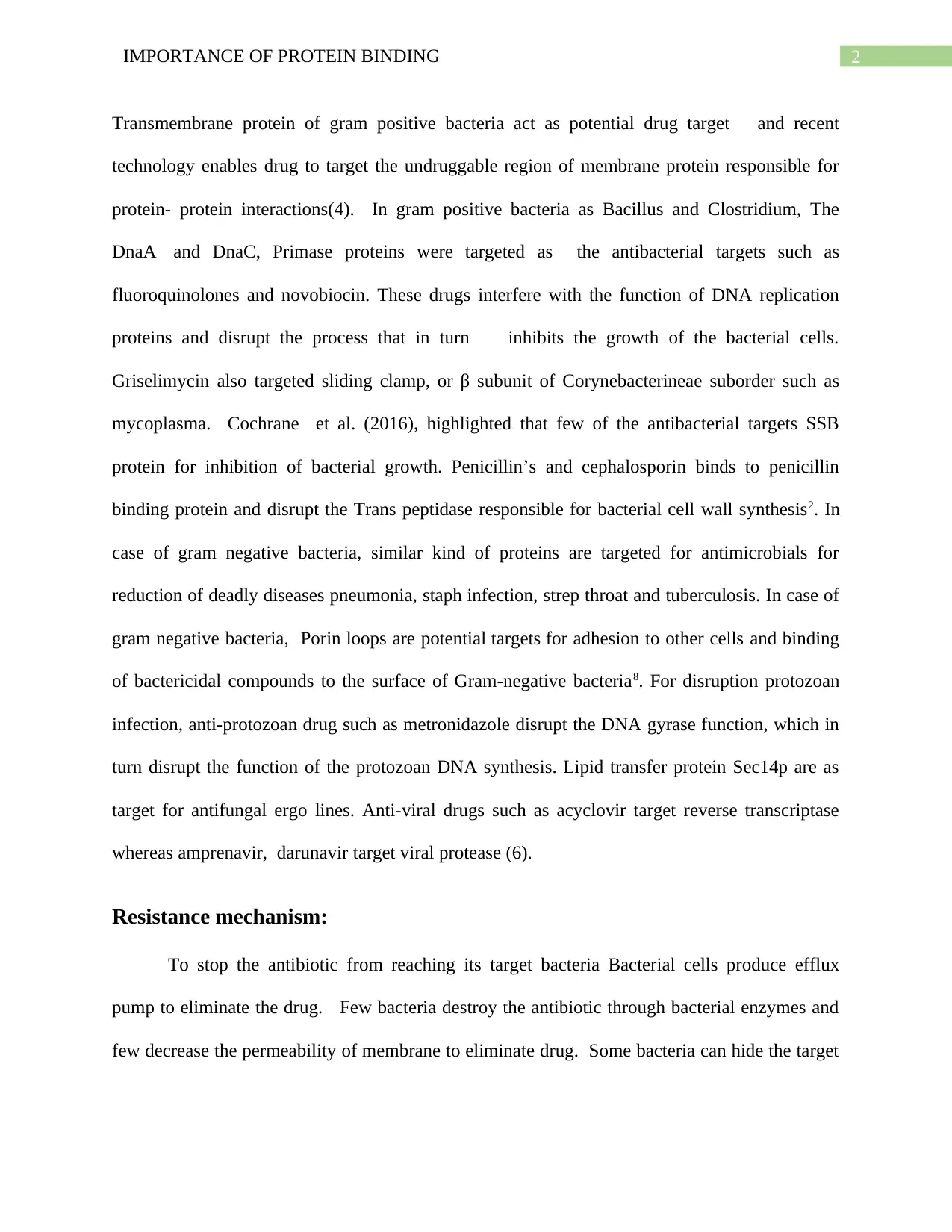
2IMPORTANCE OF PROTEIN BINDING
Transmembrane protein of gram positive bacteria act as potential drug target and recent
technology enables drug to target the undruggable region of membrane protein responsible for
protein- protein interactions(4). In gram positive bacteria as Bacillus and Clostridium, The
DnaA and DnaC, Primase proteins were targeted as the antibacterial targets such as
fluoroquinolones and novobiocin. These drugs interfere with the function of DNA replication
proteins and disrupt the process that in turn inhibits the growth of the bacterial cells.
Griselimycin also targeted sliding clamp, or β subunit of Corynebacterineae suborder such as
mycoplasma. Cochrane et al. (2016), highlighted that few of the antibacterial targets SSB
protein for inhibition of bacterial growth. Penicillin’s and cephalosporin binds to penicillin
binding protein and disrupt the Trans peptidase responsible for bacterial cell wall synthesis2. In
case of gram negative bacteria, similar kind of proteins are targeted for antimicrobials for
reduction of deadly diseases pneumonia, staph infection, strep throat and tuberculosis. In case of
gram negative bacteria, Porin loops are potential targets for adhesion to other cells and binding
of bactericidal compounds to the surface of Gram-negative bacteria8. For disruption protozoan
infection, anti-protozoan drug such as metronidazole disrupt the DNA gyrase function, which in
turn disrupt the function of the protozoan DNA synthesis. Lipid transfer protein Sec14p are as
target for antifungal ergo lines. Anti-viral drugs such as acyclovir target reverse transcriptase
whereas amprenavir, darunavir target viral protease (6).
Resistance mechanism:
To stop the antibiotic from reaching its target bacteria Bacterial cells produce efflux
pump to eliminate the drug. Few bacteria destroy the antibiotic through bacterial enzymes and
few decrease the permeability of membrane to eliminate drug. Some bacteria can hide the target
Transmembrane protein of gram positive bacteria act as potential drug target and recent
technology enables drug to target the undruggable region of membrane protein responsible for
protein- protein interactions(4). In gram positive bacteria as Bacillus and Clostridium, The
DnaA and DnaC, Primase proteins were targeted as the antibacterial targets such as
fluoroquinolones and novobiocin. These drugs interfere with the function of DNA replication
proteins and disrupt the process that in turn inhibits the growth of the bacterial cells.
Griselimycin also targeted sliding clamp, or β subunit of Corynebacterineae suborder such as
mycoplasma. Cochrane et al. (2016), highlighted that few of the antibacterial targets SSB
protein for inhibition of bacterial growth. Penicillin’s and cephalosporin binds to penicillin
binding protein and disrupt the Trans peptidase responsible for bacterial cell wall synthesis2. In
case of gram negative bacteria, similar kind of proteins are targeted for antimicrobials for
reduction of deadly diseases pneumonia, staph infection, strep throat and tuberculosis. In case of
gram negative bacteria, Porin loops are potential targets for adhesion to other cells and binding
of bactericidal compounds to the surface of Gram-negative bacteria8. For disruption protozoan
infection, anti-protozoan drug such as metronidazole disrupt the DNA gyrase function, which in
turn disrupt the function of the protozoan DNA synthesis. Lipid transfer protein Sec14p are as
target for antifungal ergo lines. Anti-viral drugs such as acyclovir target reverse transcriptase
whereas amprenavir, darunavir target viral protease (6).
Resistance mechanism:
To stop the antibiotic from reaching its target bacteria Bacterial cells produce efflux
pump to eliminate the drug. Few bacteria destroy the antibiotic through bacterial enzymes and
few decrease the permeability of membrane to eliminate drug. Some bacteria can hide the target
⊘ This is a preview!⊘
Do you want full access?
Subscribe today to unlock all pages.

Trusted by 1+ million students worldwide
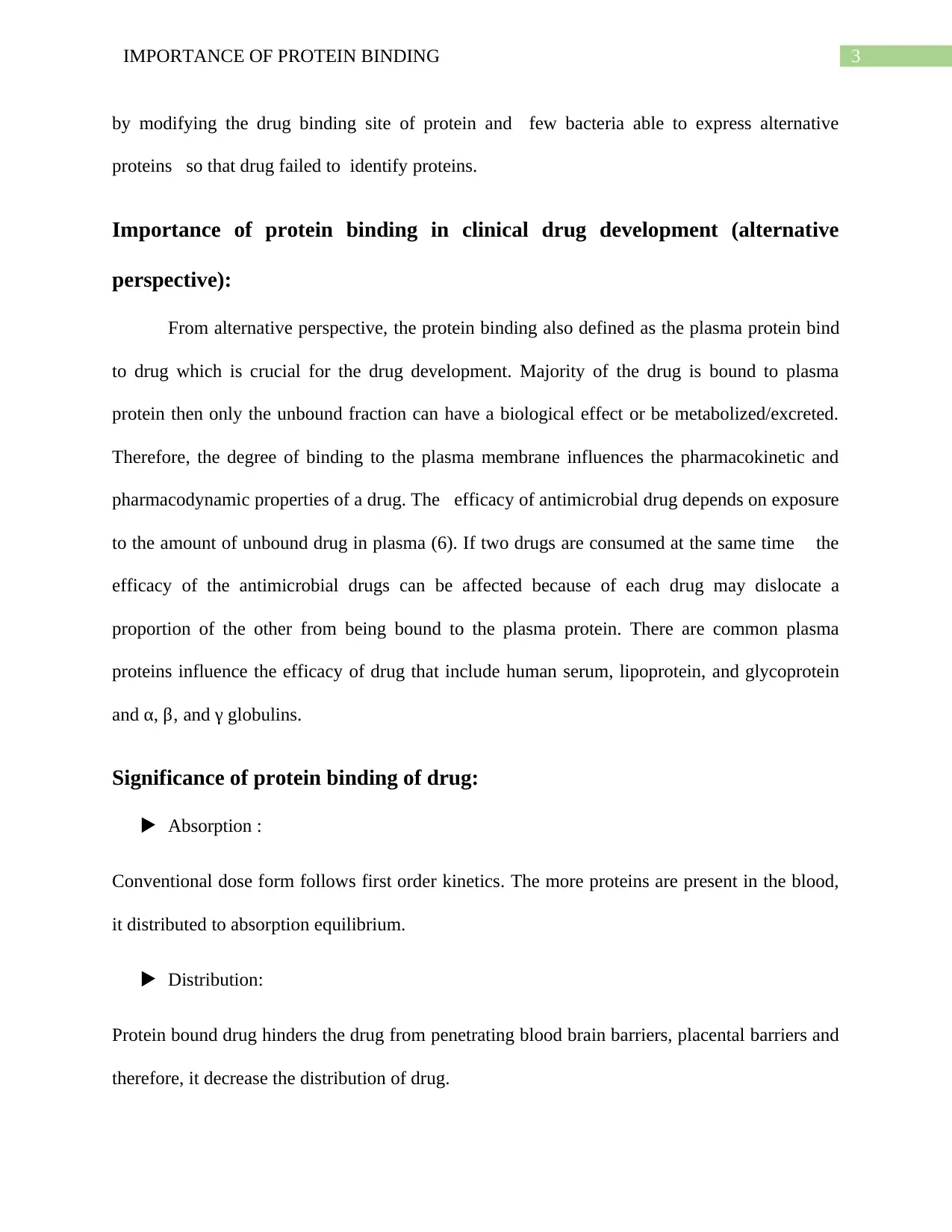
3IMPORTANCE OF PROTEIN BINDING
by modifying the drug binding site of protein and few bacteria able to express alternative
proteins so that drug failed to identify proteins.
Importance of protein binding in clinical drug development (alternative
perspective):
From alternative perspective, the protein binding also defined as the plasma protein bind
to drug which is crucial for the drug development. Majority of the drug is bound to plasma
protein then only the unbound fraction can have a biological effect or be metabolized/excreted.
Therefore, the degree of binding to the plasma membrane influences the pharmacokinetic and
pharmacodynamic properties of a drug. The efficacy of antimicrobial drug depends on exposure
to the amount of unbound drug in plasma (6). If two drugs are consumed at the same time the
efficacy of the antimicrobial drugs can be affected because of each drug may dislocate a
proportion of the other from being bound to the plasma protein. There are common plasma
proteins influence the efficacy of drug that include human serum, lipoprotein, and glycoprotein
and α, β‚ and γ globulins.
Significance of protein binding of drug:
Absorption :
Conventional dose form follows first order kinetics. The more proteins are present in the blood,
it distributed to absorption equilibrium.
Distribution:
Protein bound drug hinders the drug from penetrating blood brain barriers, placental barriers and
therefore, it decrease the distribution of drug.
by modifying the drug binding site of protein and few bacteria able to express alternative
proteins so that drug failed to identify proteins.
Importance of protein binding in clinical drug development (alternative
perspective):
From alternative perspective, the protein binding also defined as the plasma protein bind
to drug which is crucial for the drug development. Majority of the drug is bound to plasma
protein then only the unbound fraction can have a biological effect or be metabolized/excreted.
Therefore, the degree of binding to the plasma membrane influences the pharmacokinetic and
pharmacodynamic properties of a drug. The efficacy of antimicrobial drug depends on exposure
to the amount of unbound drug in plasma (6). If two drugs are consumed at the same time the
efficacy of the antimicrobial drugs can be affected because of each drug may dislocate a
proportion of the other from being bound to the plasma protein. There are common plasma
proteins influence the efficacy of drug that include human serum, lipoprotein, and glycoprotein
and α, β‚ and γ globulins.
Significance of protein binding of drug:
Absorption :
Conventional dose form follows first order kinetics. The more proteins are present in the blood,
it distributed to absorption equilibrium.
Distribution:
Protein bound drug hinders the drug from penetrating blood brain barriers, placental barriers and
therefore, it decrease the distribution of drug.
Paraphrase This Document
Need a fresh take? Get an instant paraphrase of this document with our AI Paraphraser
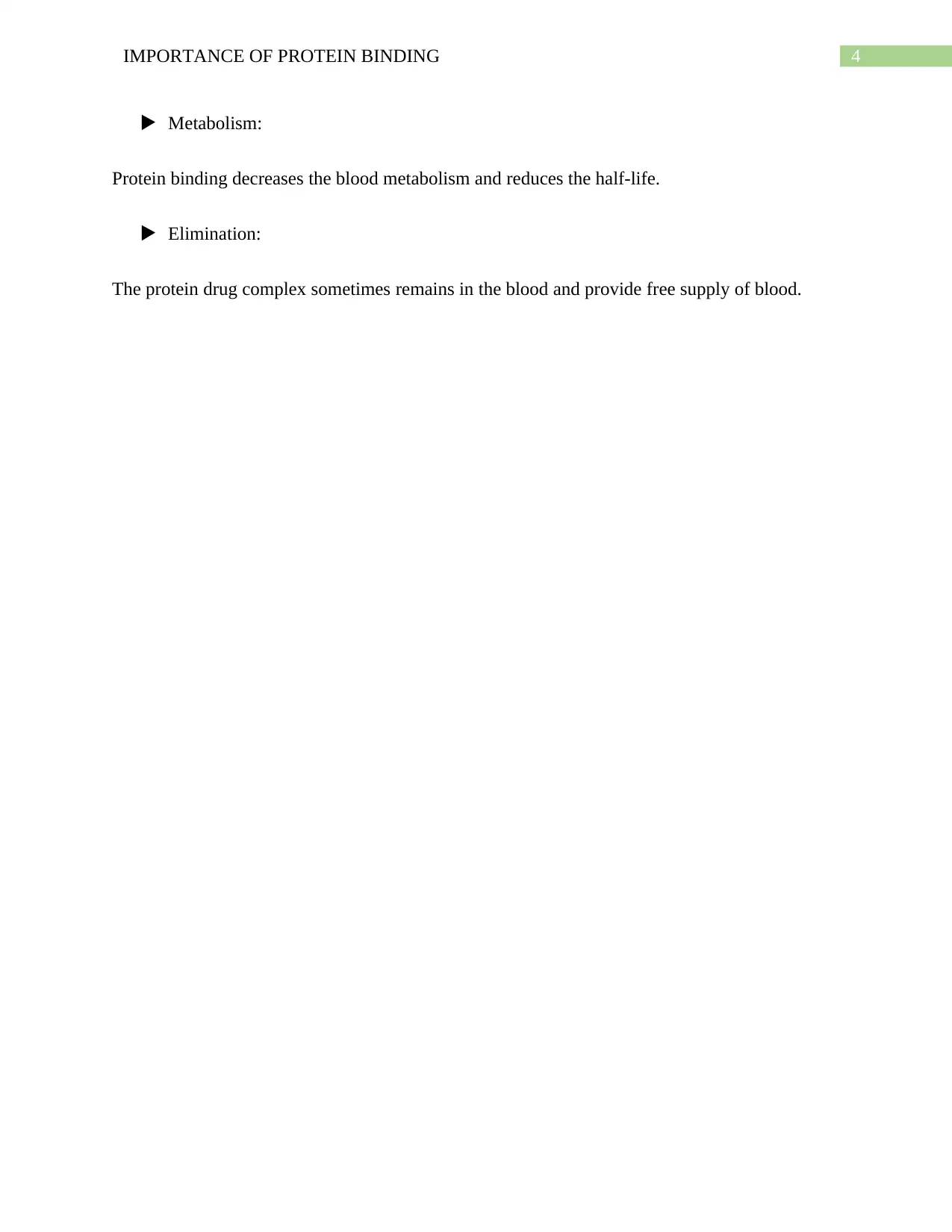
4IMPORTANCE OF PROTEIN BINDING
Metabolism:
Protein binding decreases the blood metabolism and reduces the half-life.
Elimination:
The protein drug complex sometimes remains in the blood and provide free supply of blood.
Metabolism:
Protein binding decreases the blood metabolism and reduces the half-life.
Elimination:
The protein drug complex sometimes remains in the blood and provide free supply of blood.
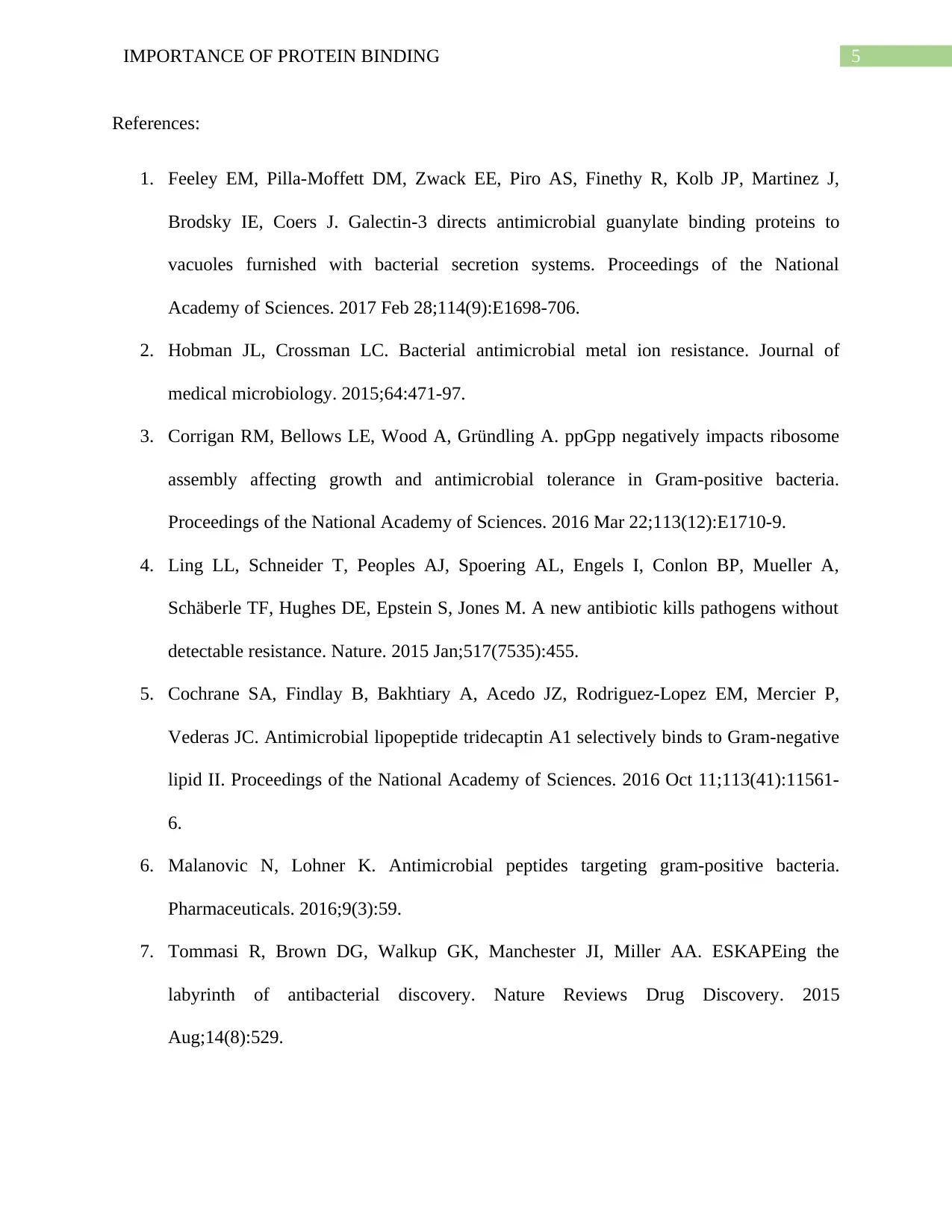
5IMPORTANCE OF PROTEIN BINDING
References:
1. Feeley EM, Pilla-Moffett DM, Zwack EE, Piro AS, Finethy R, Kolb JP, Martinez J,
Brodsky IE, Coers J. Galectin-3 directs antimicrobial guanylate binding proteins to
vacuoles furnished with bacterial secretion systems. Proceedings of the National
Academy of Sciences. 2017 Feb 28;114(9):E1698-706.
2. Hobman JL, Crossman LC. Bacterial antimicrobial metal ion resistance. Journal of
medical microbiology. 2015;64:471-97.
3. Corrigan RM, Bellows LE, Wood A, Gründling A. ppGpp negatively impacts ribosome
assembly affecting growth and antimicrobial tolerance in Gram-positive bacteria.
Proceedings of the National Academy of Sciences. 2016 Mar 22;113(12):E1710-9.
4. Ling LL, Schneider T, Peoples AJ, Spoering AL, Engels I, Conlon BP, Mueller A,
Schäberle TF, Hughes DE, Epstein S, Jones M. A new antibiotic kills pathogens without
detectable resistance. Nature. 2015 Jan;517(7535):455.
5. Cochrane SA, Findlay B, Bakhtiary A, Acedo JZ, Rodriguez-Lopez EM, Mercier P,
Vederas JC. Antimicrobial lipopeptide tridecaptin A1 selectively binds to Gram-negative
lipid II. Proceedings of the National Academy of Sciences. 2016 Oct 11;113(41):11561-
6.
6. Malanovic N, Lohner K. Antimicrobial peptides targeting gram-positive bacteria.
Pharmaceuticals. 2016;9(3):59.
7. Tommasi R, Brown DG, Walkup GK, Manchester JI, Miller AA. ESKAPEing the
labyrinth of antibacterial discovery. Nature Reviews Drug Discovery. 2015
Aug;14(8):529.
References:
1. Feeley EM, Pilla-Moffett DM, Zwack EE, Piro AS, Finethy R, Kolb JP, Martinez J,
Brodsky IE, Coers J. Galectin-3 directs antimicrobial guanylate binding proteins to
vacuoles furnished with bacterial secretion systems. Proceedings of the National
Academy of Sciences. 2017 Feb 28;114(9):E1698-706.
2. Hobman JL, Crossman LC. Bacterial antimicrobial metal ion resistance. Journal of
medical microbiology. 2015;64:471-97.
3. Corrigan RM, Bellows LE, Wood A, Gründling A. ppGpp negatively impacts ribosome
assembly affecting growth and antimicrobial tolerance in Gram-positive bacteria.
Proceedings of the National Academy of Sciences. 2016 Mar 22;113(12):E1710-9.
4. Ling LL, Schneider T, Peoples AJ, Spoering AL, Engels I, Conlon BP, Mueller A,
Schäberle TF, Hughes DE, Epstein S, Jones M. A new antibiotic kills pathogens without
detectable resistance. Nature. 2015 Jan;517(7535):455.
5. Cochrane SA, Findlay B, Bakhtiary A, Acedo JZ, Rodriguez-Lopez EM, Mercier P,
Vederas JC. Antimicrobial lipopeptide tridecaptin A1 selectively binds to Gram-negative
lipid II. Proceedings of the National Academy of Sciences. 2016 Oct 11;113(41):11561-
6.
6. Malanovic N, Lohner K. Antimicrobial peptides targeting gram-positive bacteria.
Pharmaceuticals. 2016;9(3):59.
7. Tommasi R, Brown DG, Walkup GK, Manchester JI, Miller AA. ESKAPEing the
labyrinth of antibacterial discovery. Nature Reviews Drug Discovery. 2015
Aug;14(8):529.
⊘ This is a preview!⊘
Do you want full access?
Subscribe today to unlock all pages.

Trusted by 1+ million students worldwide
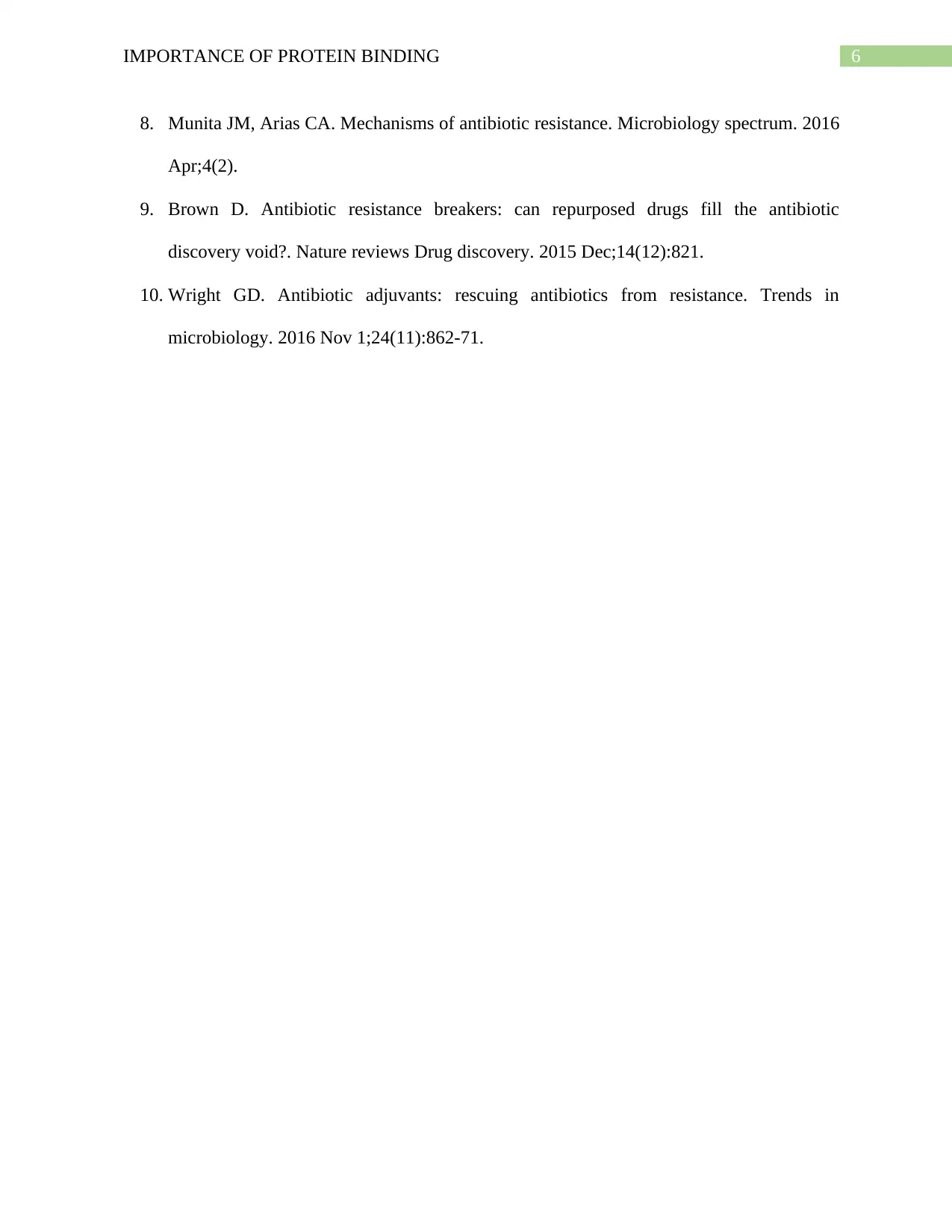
6IMPORTANCE OF PROTEIN BINDING
8. Munita JM, Arias CA. Mechanisms of antibiotic resistance. Microbiology spectrum. 2016
Apr;4(2).
9. Brown D. Antibiotic resistance breakers: can repurposed drugs fill the antibiotic
discovery void?. Nature reviews Drug discovery. 2015 Dec;14(12):821.
10. Wright GD. Antibiotic adjuvants: rescuing antibiotics from resistance. Trends in
microbiology. 2016 Nov 1;24(11):862-71.
8. Munita JM, Arias CA. Mechanisms of antibiotic resistance. Microbiology spectrum. 2016
Apr;4(2).
9. Brown D. Antibiotic resistance breakers: can repurposed drugs fill the antibiotic
discovery void?. Nature reviews Drug discovery. 2015 Dec;14(12):821.
10. Wright GD. Antibiotic adjuvants: rescuing antibiotics from resistance. Trends in
microbiology. 2016 Nov 1;24(11):862-71.
1 out of 7
Related Documents
Your All-in-One AI-Powered Toolkit for Academic Success.
+13062052269
info@desklib.com
Available 24*7 on WhatsApp / Email
![[object Object]](/_next/static/media/star-bottom.7253800d.svg)
Unlock your academic potential
Copyright © 2020–2025 A2Z Services. All Rights Reserved. Developed and managed by ZUCOL.




